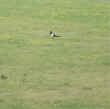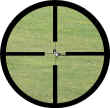RIFLES
Another method of using decoys
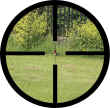
Greycrows
& Magpies
Rifles
used for decoying are primarily used to shoot greycrows and magpies. Both
greycrows and magpies eat carrion and are especially busy at the end of March
and early April feeding their young. Carrion is a welcome addition to their diet
and both readily approach when it's placed in a field some distance from the
hedge. They seem to feel more secure in the fact that they can see for some
distance all around them and it would be difficult for an enemy to approach
unnoticed.

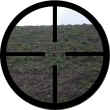
This
can be used to the hunters advantage to lure both greycrows and magpies into
decoys beside carrion. We have used children's furry toys as "carrion",
which have 3 / 4 greycrows "eating" them while 5 / 6 magpie decoys are
some distance away waiting to move in on the left-overs. This picture is made
more realistic by the use of an electronic magpie call, which seems to draw them
in quite quickly. We wait in a hide set up in the hedge which is 75 metres away,
the distance the rifles are sighted in to. A .22 LR rifle is adequate to dispatch
these birds at this distance. This type of rifle shooting can be tricky and
demanding as the crows are constantly on the move hopping about and bobbing up
and down in search of food. Just as one is about to pull the trigger the target
decides to move. Shots can be far and few between, at times, but a hit can be
quite rewarding in terms of achievement.
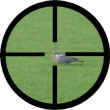
Real
carrion can also be used. If rabbit shooting and you have no use for the rabbits
then they can be placed in a field to attract the greycrows and magpies. If this
is done on a regular basis the corvids will readily approach the site each day,
hoping for some fresh pickings. Similarly, dead sheep, lambs etc. attract the
greycrows and magpies and an ambush can be set up.
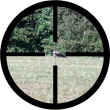
Another
method is to patrol the area in spring, summer and autumn searching for fields
that have been freshly ploughed, freshly seeded or where hay or silage has
recently been harvested. All of these fields are magnets for crows
and a hide set in a hedge can pay dividends.


As
crows can be encountered at various distances it is advantageous to know the
distance the target is from the hide. We use a rangefinder to achieve this. A
rangefinder is an optical instrument which determines range when pointed at an
object. When sighting in a scope for a .22 LR rifle it is advisable to be able
to click up or down for various distances. We sight in the rifle at 100 yards.
This we class as ZERO. We then sight the rifle in at 50 yards and count the
number of clicks down from zero, while adjusting. Similarly, we count the clicks
down to 75 yards and up to 125 and 150 yards. A note of the number of clicks required to be
accurate at set distances is recorded in a notebook for future reference. This
method means a shot can be taken between 50 and 150 yards knowing that the scope
is sighted in accurately for the distance, once the correct number of clicks is
entered.
Greycrow
spotted in field

Rangefinder
indicates distance
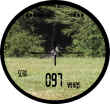
Rifle
scope is clicked up to known 100 yard setting (Zero)

When
decoying using a rifle the most important aspect of the whole set up is to have
a safe backdrop. A hilly field is ideal for the purpose. The shooter needs to
know the field layout really well and be able to determine where anyone may
approach from. Constant monitoring of the area is vital to ensure nothing
approaches the line of fire.



The
use of sub sonic ammunition is highly recommended as there is very little
noise and birds often continue feeding after a shot has been fired, even when
one of their comrades has been killed! If birds rise and fly off after a
shot they often return quite quickly to feast again, unsure of what happened.
